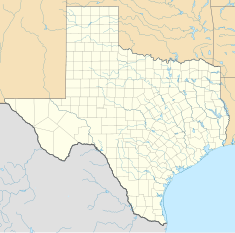Spanish Fort, Texas
|
Spanish Fort Site
|
|
 |
|
|
Location of Spanish Fort in Texas
|
|
| Location | Montague County, Texas |
|---|---|
| Nearest city | Nocona, Texas |
| Coordinates | 33°57′7.2318″N 97°37′36.0948″W / 33.952008833°N 97.626693000°WCoordinates: 33°57′7.2318″N 97°37′36.0948″W / 33.952008833°N 97.626693000°W |
| Area | 100 acres (40 ha) |
| Built | 1759 |
| NRHP Reference # | 75002000 |
| # | 369976 |
| Significant dates | |
| Significant Event | 1759 |
| Added to NRHP | April 14, 1975 |
| Designated | April 14, 1975 |
Spanish Fort is an unincorporated community in north central Montague County, Texas, United States at the end of Farm Road 103 one mile south of the Red River.
Native Americans long used the fertile areas near the Red River for farming and hunting. Taovoyas, flying the French flag, established a fort here around 1750 to defend against Spanish incursions in the area. In 1759, in the Battle of the Twin Villages, a Spanish army under Col. Diego Ortiz Parrilla attacked the Taovoyas' fortified position, but were defeated by a force of both the Taovoyas and Comanche tribes. Anglo settlers later misnamed the area Spanish Fort after assuming that the Spanish forces had built a fortification there, rather than the Native Americans.
By 1859, Anglos began settling the area as the population of Native Americans dwindled. White settlement was encouraged across the newly formed Republic of Texas, and though Texas became a state in 1845, European settlers kept coming to Texas for farm land. By the early 1870s, a town called Burlington had been established near present-day Spanish Fort. The town was strategically located along the Chisholm Trail, and it became a popular cowboy town on the cattle drives from south and central Texas to Kansas. Nearby Red River Station, Texas, was the last stop before entering Indian Territory and virtually all cattle driven along the Chisolm Trail crossed at Red River Station. The town grew and citizens applied for a post office in 1876, but were rejected based on another Texas town of the same name. Two local men suggested the misnomer "Spanish Fort" after the ruins nearby. The new name was accepted, and the Spanish Fort post office opened in 1877.
At its peak, the town had numerous businesses and churches, a Masonic lodge, five physicians, four hotels, and several saloons. Spanish Fort became known as a very rough and tumble cowboy town, and at least 40 murders are said to have occurred during the cattle drive heyday.
...
Wikipedia

